AH-1 Cobra
- For an overview of the whole Huey family of aircraft see Bell Huey
| AH-1 HueyCobra/Cobra | |
|---|---|
 |
|
| A Bell AH-1G HueyCobra | |
| Role | Attack helicopter |
| Manufacturer | Bell Helicopter |
| First flight | 7 September 1965 |
| Introduction | 1967 |
| Status | Active service |
| Primary users | United States Army Japan Self Defense Forces Republic of Korea Army Israeli Air Force |
| Produced | 1967-present |
| Number built | 1,116 |
| Unit cost | US$11.3 million (1995) (AH-1 HueyCobra)[1] |
| Developed from | UH-1 Iroquois |
| Variants | AH-1 SuperCobra Bell 309 KingCobra |
The AH-1 Cobra (company designation: Bell 209) is a two-bladed, single engine attack helicopter manufactured by Bell. It shares a common engine, transmission and rotor system with the older UH-1 Iroquois. The AH-1 is also sometimes referred to as the HueyCobra or Snake.
The AH-1 was the backbone of the United States Army's attack helicopter fleet, but has been replaced by the AH-64 Apache in Army service. Upgraded versions continue to fly with several other users. The AH-1 twin engine versions remain in service with United States Marine Corps as the service's primary attack helicopter.
Contents |
Development
Background
Closely related with the development of the Bell AH-1 is the story of the Bell UH-1 — predecessor of the modern helicopter, icon of the Vietnam War and still one of the most numerous helicopter types in service today.
The UH-1 made the theory of air cavalry practical, as the new tactics called for US forces to be highly mobile across a wide area. Unlike before, they would not stand and fight long battles, and they would not stay and hold positions. Instead, the plan was that the troops carried by fleets of UH-1 Hueys would range across the country, to fight the enemy at times and places of their own choice.[2]
It soon became clear that the unarmed troop helicopters were vulnerable against ground fire from Việt Cộng and North Vietnamese troops, particularly as they came down to drop their troops in a landing zone. Without friendly support from artillery or ground forces, the only way to pacify a landing zone was from the air, preferably with a machine that could closely escort the transport helicopters, and loiter over the landing zone as the battle progressed. By 1962 a small number of armed UH-1As were used as escorts, armed with multiple machine guns and rocket mounts.[3]
The massive expansion of American military presence in Vietnam opened a new era of war from the air. The linchpin of US Army tactics were the helicopters, and the protection of those helicopters became a vital role.[4]
Bell 207 Sioux Scout
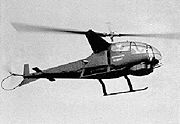
Bell had been investigating helicopter gunships since the late 1950s, and had created a mockup of its D-255 helicopter gunship concept, named "Iroquois Warrior". In June 1962, Bell displayed the mockup to Army officials, hoping to solicit funding for further development. The D-255 Iroquois Warrior was planned to be a purpose-built attack aircraft based on the UH-1B airframe and dynamic components with a new, slender airframe and a two-seat, tandem cockpit. It featured a nose-mounted ball turret, a belly-mounted gun pod, and stub wings for mounting rockets or SS-10 anti-armor missiles.[5]
The Army was interested and awarded Bell a proof of concept contract in December 1962. Bell modified a Model 47, leading to the sleek Model 207 Sioux Scout which first flew in July 1963.[6] The Sioux Scout had all the key features of a modern helicopter gunship – a tandem cockpit, stub wings for weapons, and a chin-mounted gun turret. After evaluating the Sioux Scout in early 1964, the Army was impressed, but also believed the Sioux Scout was too small, underpowered, unsophisticated, and fragile to be of practical use.[6]
AAFSS
Army's solution to the shortcomings of the Sioux Scout was to launch the Advanced Aerial Fire Support System (AAFSS) competition.[6] The AAFSS requirement would give birth to the Lockheed AH-56 Cheyenne – a heavy battlefield helicopter that would prove to be over-ambitious, over-complex and over-budget, before being canceled 10 years later in 1972.[6] The Cheyenne program developed future technology and demonstrated some impressive performance, but was never made to work as a functional gunship. It served to underline an important rule of the combat helicopter – survival would be ensured only by the right mix of speed, agility and weapons.
Model 209

At the same time, despite the Army's preference for the AAFSS – for which Bell Helicopter was not selected to compete – Bell stuck with their own idea of a smaller and lighter gunship.[6] In January 1965 Bell invested $1 million to proceed with a new design.
Mating the proven transmission, the "540" rotor system of the UH-1C augmented by a Stability Control Augmentation System (SCAS), and the T53 turboshaft engine of the UH-1 with the design philosophy of the Sioux Scout, Bell produced the Model 209.[6] Bell's Model 209 largely resembled its "Iroquois Warrior" mockup.[5]
In Vietnam, events were also advancing in favor of the Model 209. Attacks on US forces were increasing, and by the end of June 1965 there were already 50,000 US ground troops in Vietnam.[6]
1965 was also the deadline for AAFSS selection, but the program was stuck in technical difficulties and political bickering. The U.S. Army needed an interim gunship for Vietnam and it asked five companies to provide a quick solution. Submissions came in for armed variants of the Boeing-Vertol ACH-47A, Kaman HH-2C Tomahawk, Piasecki 16H Pathfinder, Sikorsky S-61, and the Bell 209.[6]
On 3 September 1965 Bell rolled out the prototype, and four days later it made its maiden flight, only eight months from the go-ahead. In April 1966, the Model 209 won an evaluation against the other rival helicopters. Then the Army signed the first production contract for 110 aircraft.[6]
The Bell 209 demonstrator was used for the next six years to test weapons and fit of equipment. It had been modified to the match AH-1 production standard by the early 1970s. The demonstrator was retired to the Patton Museum at Fort Knox, KY and converted to approximately its original appearance.[5]
Into production
The Bell 209 design was modified for production. The retractable skids were replaced by simpler fixed skids. A new wide-blade rotor was featured. For production, a plexiglass canopy replaced the 209's armored glass canopy which was heavy enough to harm performance.[5]
Operational history
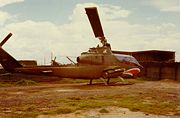
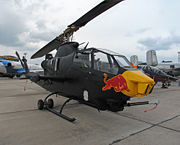
US Army
By June 1967, the first AH-1G HueyCobras had been delivered. Originally designated as UH-1H, the "A" for attack designation was soon adopted and when the improved UH-1D became the UH-1H, the HueyCobra became the AH-1G.[6] The AH-1 was initially considered a variant of the H-1 line, resulting in the G series letter.
Bell built 1,116 AH-1Gs for the US Army between 1967 and 1973, and the Cobras chalked up over a million operational hours in Vietnam.[6]
The AH-1 Cobras were in use by the Army during the Tet offensive in 1968 and through the end of the Vietnam War. Huey Cobras provided fire support for ground forces, escorted transport helicopters and other roles, including aerial rocket artillery (ARA) battalions in the two Airmobile divisions. They also formed "hunter killer" teams by pairing with OH-6A scout helicopters. A team featured one OH-6 flying slow and low to find enemy forces. If the OH-6 drew fire, the Cobra could strike at the then revealed enemy.[5]
Huey Cobras supported U.S. Marine operations during 1983 invasion of Grenada.
During the Gulf War of 1990-91, the Cobras and SeaCobras deployed in a support role. The Marines deployed 91 SeaCobras and the Army 140 Cobras. Three AH-1s were lost in accidents during fighting and afterwards.[5] U.S. Cobras were also used in operations throughout the 1990s.[5]
AH-1 Cobras continue to operate with the US military, by the US Marine Corps notably in the ongoing conflict in Iraq. The US Army phased out the AH-1 during the 1990s and retired the AH-1 from active service in March 1999.[6][7] The Army retired the AH-1 from reserves in September 2001. The retired AH-1s have been passed to other nations and to the USDA Forest Service.[6]
Israel
Since the mid-1970s Lebanon has been Israel's most active front. The Cobra helicopter's unique abilities and its precision weapons have made it perfect for the Lebanese theatre and IAF Cobras have been a constant feature of the fighting for more than 20 years. The first Cobra attack took place on May 9th 1979, near Tyre. Having crossed the border over the Mediterranean at dusk, two AH-1s scored direct hits with 2 missiles fired by each helicopter.
Cobra helicopter gunships were also used widely by the Israeli Air Force in the 1982 Lebanon War to destroy Syrian armor and fortification. IAF Cobras destroyed dozens of Syrian armored fighting vehicles, including many of the modern Soviet T-72 main battle tanks. As part of their service in southern Lebanon the Cobras were very active in Israel's major operations against Hizbullah, operations "Accountability" and "Grapes of Wrath".
The Israeli Air Force also operates the Cobra as the "Tzefa" (צפע), Hebrew for Viper,[8] with highly favorable reviews.
Pakistan
The Pakistan Army has also used the AH-1 as its primary gunship helicopter during the mid-1970s tribal uprising in Pakistan's Baluchistan province. The recent insurgencies in the Waziristan regions has seen Pakistani AH-1s seeing action against Taliban & Al Qaeda fighters and their tribal allies, as well as operations against insurgents in another more recent Baluch tribal uprising recently led by armed Bugti and Marri tribesmen under the late Nawab Akbar Khan Bugti and the Balochistan Liberation Army since the mid-2000s.
US Forest Service
In 2003, the US Forest Service acquired 25 retired AH-1Fs from the US Army.[6] These have been designated Bell 209 and are being converted into Firewatch Cobras with infared and low light sensors and systems for real time fire monitoring.[9][10] The Florida Department of Forestry has also acquired 3 AH-1Ps from US Army. These are called Bell 209 "Firesnakes" and are equipped to carry a water/fire retardant system.[6]
Variants
Single-engined:
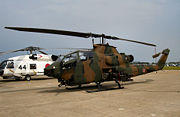
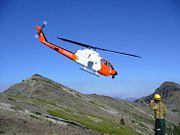
- Bell 209
- Original AH-1G prototype with retractable skid landing gear. This model number is also used by the FAA for the civilian registration of former U.S. Army AH-1s used in firefighting service.
- AH-1G HueyCobra
- Initial 1966 production model gunship for the US Army, with one 1,400shp Avco Lycoming T53-13 turboshaft.
- JAH-1G HueyCobra
- One helicopter for armament testing including Hellfire missiles and multi-barrel cannon.[11]
- TH-1G HueyCobra
- Two-seat dual-control trainer.[11] The principal difference was addition of hydraulically boosted controls in front cockpit to equalize mechanical advantage with rear cockpit.
- Z.14 HueyCobra
- Spanish Navy designation of the AH-1G.[11]
- YAH-1Q
- Eight AH-1Gs with XM26 Telescopic Sight Unit (TSU) and two M56 TOW 4-pack launchers.[5]
- AH-1Q HueyCobra
- Equipped with the M65 TOW/Cobra missile subsystem, M65 Telescopic Sight Unit (TSU), and M73 Reflex sight. All future versions will be equipped with the TSU and be equipped to fire the TOW missile subsystem.
- YAH-1R
- AH-1G powered by a T53-L-703 engine without TOW system.[5]
- YAH-1S
- AH-1Q upgrade and TOW system.[5]
- AH-1S
- The baseline AH-1S is an AH-1Q upgraded with a 1,800 shp T53-L-703 turboshaft engine. The AH-1S is also referred to as the "Improved AH-1S", "AH-1S Modified", or "AH-1S(MOD)" prior to 1988. (Prior to 1988, all upgraded aircraft were referred to as variants of the AH-1S.)
- AH-1P
- 100 production aircraft with composite rotors, flat plate glass cockpit, and improved cockpit layout for nap-of-earth (NOE) flight. The AH-1P is also referred to as the "Production AH-1S", or "AH-1S(PROD)" prior to 1988. These improvements are considered Step 1 of the AH-1S upgrade program.
- AH-1E
- 98 production aircraft with the Enhanced Cobra Armament System (ECAS) featuring the M97A1 armament subsystem with a three-barreled M197 20 mm cannon. The AH-1E is also referred to as the "Upgunned AH-1S", or "AH-1S(ECAS)" prior to 1988. These improvements are considered Step 2 of the AH-1S upgrade program. AH-1E aircraft did not have the M147 Rocket Management Subsystem (RMS) and were unable to fire 2.75 inch rockets.[5]
- AH-1F
- 143 production aircraft and 387 converted AH-1G Cobras. The AH-1F incorporates all Step 1 and 2 upgrades to the AH-1S as well as a return of the M147 RMS, an M143 Air Data Subsystem (ADS), a laser rangefinder and tracker, an infrared jammer mounted above the engine exhaust, and an infrared suppressing engine exhaust system. The AH-1F is also referred to as the "Modernized AH-1S", "AH-1S Modernized Cobra", or "AH-1S(MC)" prior to 1988.
- Model 249
- Experimental demonstrator version fitted with a four-bladed rotor system, an uprated engine and experimental equipment, including Hellfire missiles.[5]
- Bell 309 KingCobra
- Experimental version powered by one Lycoming T-55-L-7C engine.[12]
Twin-engined:
- For AH-1J, AH-1T, AH-1W, AH-1Z and other twin-engine variants, see AH-1 SuperCobra.
Operators
- See also: AH-1 SuperCobra for operators of AH-1J, AH-1T, AH-1W, AH-1Z and other twin-engine variants.
Current operators
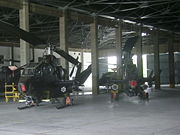


- Bahrain Air Force acquired 24 AH-1Ps and 6 TAH-1P trainers.[5] Bahrain has 10 AH-1Es, 6 AH-1Ps and 6 TAH-1Ps in inventory as of 2008.[13]
- Israeli Air Force has 55 AH-1 "Tzefa" צפע ("Viper"), consisting of S, F, F and G variants in inventory as of 2008.[13]
- Japan Ground Self-Defense Force received 2 AH-1Es[5] and 89 AH-1S Cobras license-manufactured by Fuji Heavy Industries from 1984 to 2000.[14]
- Jordanian Air Force received 24 AH-1Ss and 9 AH-1Fs.[5] Jordon has 22 AH-1S and 9 AH-1F Cobras in use as of 2008.[13]
- Pakistan Army received 20 AH-1S Cobras in the 1980s (later upgraded to AH-1F) and ordered more AH-1Fs in 2004.[5] Pakistan has 39 AH-1S and AH-1F Cobras in use as of November 2008.[15] Pakistan has recently ordered more Cobras in 2008.
- Republic of Korea Army received 90 AH-1Fs (originally designated AH-1S).[5]
- Turkish Army received 32 used AH-1P/S Cobras. These were upgraded to AH-1F standards.[6] The Turkish Army has 23 AH-1 Cobras in inventory as of 2008.[13]
- U.S. Forest Service (25 AH-1Fs, converting to Bell 209 Firewatch Cobras)[9]
- Florida Department of Forestry (3 AH-1Ps, converting to Bell 209 "Firesnakes")[6]
Former operators
- Spanish Navy received 8 AH-1G.
- United States Army replaced its AH-1s with AH-64 Apaches.
- United States Customs Service used a small number of AH-1Gs between 1981 and 1986.
- United States Marine Corps used AH-1Gs prior to delivery of AH-1Js.
Specifications
AH-1G HueyCobra
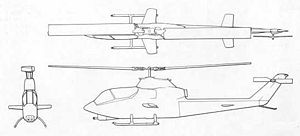
Data from Modern Military Aircraft[16]
General characteristics
- Crew: 2 - one pilot, one CPG (co-pilot/gunner)
- Length: 44 ft 5 in (13.4 m)
- Rotor diameter: 44 ft (13.4 m)
- Height: 13 ft 5 in (4.1 m)
- Empty weight: 6,073 lb (2,754 kg)
- Max takeoff weight: 9,500 lb (4,309 kg)
- Powerplant: 1× AVCO Lycoming T53-L-13 turboshaft, 1,100 shp (820 kW)
- Rotor system: 2 blades on main rotor
Performance
- Maximum speed: 190 knots (219 mph, 352 km/h)
- Range: 310 nmi (357 mi, 574 km)
- Service ceiling 11,400 ft (3,475 m)
- Rate of climb: 1,230 ft/min (6.25 m/s)
Armament
- 2 7.62 mm (0.308 in) multi-barrel Miniguns, or 2 M129 40 mm Grenade launchers, or one of each, in the M28 turret
- 2.75 in (70 mm) rockets - 7 rockets mounted in the M158 launcher or 19 rockets in the M200 launcher
- M18 7.62 mm Minigun pod or XM35 armament subsystem with XM195 20 mm cannon
AH-1F "Modernized" Cobra

General characteristics
- Crew: 2 - one pilot, one CPG (co-pilot/gunner)
- Length: 44 ft 7 in (13.6 m)
- Rotor diameter: ft (m)
- Height: 13 ft 5 in (4.1 m)
- Empty weight: 6,600 lb (2,993 kg)
- Max takeoff weight: 10,000 lb (4,500 kg)
- Powerplant: 1× AVCO Lycoming T53-L-703 turboshaft, 1,800 shp (1,300 kW)
- Rotor system: 2 blades on main rotor
Performance
- Maximum speed: 149 knots (172 mph, 277 km/h)
- Range: 274 nmi (315 mi, 510 km)
- Service ceiling 12,200 ft (3,720 m)
- Rate of climb: 1,620 ft/min (8.2 m/s)
Armament
- M197 3-barreled 20 mm "Gatling-style" cannon
- Hydra 70 2.75 in (70 mm) rockets - 7 rockets mounted in the M260 launcher or 19 rockets in the M261 launcher[17]
- TOW Missiles - 4 or 8 missiles mounted in two-missile launchers on each hardpoint
See also
- U.S. Helicopter Armament Subsystems, AH-1 Cobra
Related development
- Bell 207 Sioux Scout
- UH-1 Iroquois
- AH-1 SuperCobra
- AH-1Z Viper
- Bell 309 KingCobra
- Bell YAH-63
Comparable aircraft
- AH-64 Apache
- Kamov Ka-50
- Mil Mi-24
- Mil Mi-28
- HAL Light Combat Helicopter
Related lists
- List of attack aircraft
- List of helicopters
- List of active United States military aircraft
References
- ↑ Military aircraft prices
- ↑ Wheeler 1987, p. 62-64.
- ↑ Wheeler 1987, p. 57-62, 64-65.
- ↑ Wheeler 1987, p. 60-61.
- ↑ 5.00 5.01 5.02 5.03 5.04 5.05 5.06 5.07 5.08 5.09 5.10 5.11 5.12 5.13 5.14 5.15 5.16 5.17 Bishop, Chris. Huey Cobra Gunships. Osprey Publishing, 2006. ISBN 1-84176-984-3.
- ↑ 6.00 6.01 6.02 6.03 6.04 6.05 6.06 6.07 6.08 6.09 6.10 6.11 6.12 6.13 6.14 6.15 6.16 Donald, David and March, Daniel. Modern Battlefield Warplanes. AIRtime Publishing Inc, 2004. ISBN 1-880588-76-5.
- ↑ Army retires Cobras from active force, U.S. Army, March 31, 1999.
- ↑ "Bell AH-1 Huey-Cobra". Israeli Air Force. Retrieved on 2007-03-15.
- ↑ 9.0 9.1 Firewatch Helicopter page, US Forest Service, 2004.
- ↑ Bell 209 Firewatch Cobra on USDA Forest Service site
- ↑ 11.0 11.1 11.2 Donald, David. The Complete Encyclopedia of World Aircraft. Barnes & Nobel Books, 1997. ISBN 0-7607-0592-5.
- ↑ Model 309 Kingcobra / Model 409 AAH (YAH-63), Vectorsite.net
- ↑ 13.0 13.1 13.2 13.3 "World Military Aircraft Inventory". 2008 Aerospace Source Book. Aviation Week and Space Technology, January 28, 2008.
- ↑ "Apache wins Japan deal", Flight International, 4 September, 2001.
- ↑ 15.0 15.1 "Directory: World Air Forces", Flight International, 11-17 November 2008.
- ↑ Gunston, Bill: The Illustrated Encyclopedia of the World's Modern Military Aircraft, page 205. Crescent Books, New York, NY USA, ca. 1978. ISBN 978-0-517-22477-9
- ↑ U.S. Army Helicopter Weapon Systems
- Gunston, B.; Spick, M. (1986). Modern Fighting Helicopters. New York: Crescent Books. pp. 104–05. ISBN 0-517-61349-2.
- International Air Power Review, Volume 12. AIRtime Publishing. 2004. ISBN 1-880588-77-3.
- Nolan, Keith W. (l986). Into Laos: Dewey Canyon II/Lam Son 719, Vietnam 1971. Presidio Press. ISBN 0891412476.
- Wheeler, Howard A. (l987). Attack Helicopters, A History of Rotary-Wing Combat Aircraft. The Nautical and Aviation Publishing Company. ISBN 0933852-52-5.
External links
- AH-1 Cobra US Army fact sheet and US Army Cobra page
- AH-1 Cobra page on GlobalSecurity.org
- AH-1 Cobra page on GlobalAircraft.org
- Bell 209/AH-1 Tzefa Israeli Air Force Inventory
- Firewatch Helicopter page and Bell 209 Firewatch Cobra on USDA Forest Service site
- The Bell AH-1 HueyCobra on Vectorsite.net
- AH-1 HueyCobra page on Rotorhead.org
- AH-1 Cobra Photo Galleries on MidwaySailor.com
- Historic US Army Helicopters - AH-1 Series Huey Cobra
- US Army Attack Helicopters (Vietnam Era)
- Bell Model 209 "Huey Cobra"
|
||||||||
|
||||||||
|
||||||||||||||